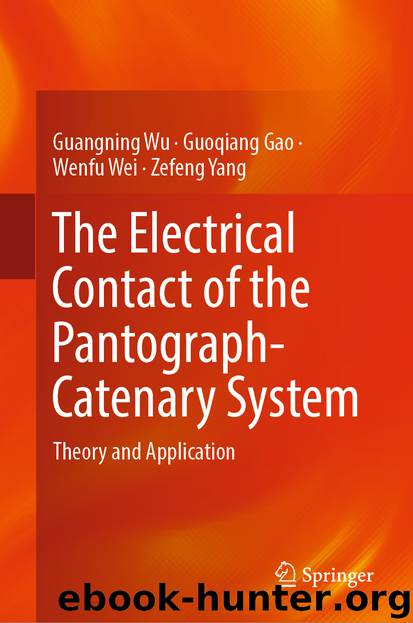The Electrical Contact of the Pantograph-Catenary System by Guangning Wu & Guoqiang Gao & Wenfu Wei & Zefeng Yang

Author:Guangning Wu & Guoqiang Gao & Wenfu Wei & Zefeng Yang
Language: eng
Format: epub
ISBN: 9789811365898
Publisher: Springer Singapore
In order to study the influence of train running speed on the arc resistance of pantograph and catenary, Fig. 4.14 gives the voltage/ampere characteristic curve of arc in a period (0.042–0.062 s). Among them, (a), (b) are the voltage/ampere characteristic curve and the corresponding local amplification diagram A, B under train running speed of 100, 400 km/h.
From Fig. 4.14, it can be seen that the voltage and current of pantograph and catenary electric arc are highly nonlinear, and the electric arc resistance is equal to the instantaneous value of the arc voltage and the instantaneous value of the arc current. When the pantograph and catenary are off-line, the arc voltage reaches the breakdown voltage of the pantograph and catenary gap, the pantograph and catenary electric arc occurs, the electric arc resistance decreases rapidly, and the current begins to increase. When the arc current reaches the maximum, the electric arc resistance rises slowly and the current decreases. When the current is about zero, the electric arc resistance will increase rapidly. At this time, the arc is re-ignition if the recovery degree of the medium gap air medium of pantograph and catenary is less than the voltage recovery degree on the arc gap. In this process, the arc voltage/ampere characteristic curve is composed of two curves, 1 and 2 of Fig. 4.14a, curve 1 reflects the characteristic of the arc current increasing, curve 2 reflects the characteristic of the arc current decreasing, and curve 2 is below the curve 1 because of the thermal inertia of the electrode and the arc column gas. The arc voltage/ampere characteristic curve of pantograph and catenary is approximate to magnetic hysteresis line, and the slope of stable arc in one period is negative.
Comparing Fig. 4.14a, b, the voltage/ampere characteristic curves at speeds of 100 and 400 km/h are similar to magnetic hysteresis line, but the arc voltage amplitude of 400 km/h is larger. When the arc current is maximum value, the electric arc resistance of 100 km/h is 22.5 mΩ, and the electric arc resistance of 400 km/h is 25.8 mΩ, the speed increases, and the electric arc resistance increases. In order to compare the influence of the zero-crossing stage and the velocity on the electric arc resistance, the voltage/ampere characteristics of A and B in the zero-crossing region are amplified. In the voltage range from −50 to 50 V, the greater the velocity, the greater the slope of the curve (the arc resistance) and the speed of 400 km/h, the voltage is asymmetrical in this range. It can be seen that when the train speed increases, the arc resistance will also increase.
2.Influence of elevating pantograph on electrical characteristics of pantograph and catenary electric arc [8, 12, 13]
Download
This site does not store any files on its server. We only index and link to content provided by other sites. Please contact the content providers to delete copyright contents if any and email us, we'll remove relevant links or contents immediately.
| Automotive | Engineering |
| Transportation |
Whiskies Galore by Ian Buxton(41708)
Introduction to Aircraft Design (Cambridge Aerospace Series) by John P. Fielding(33011)
Small Unmanned Fixed-wing Aircraft Design by Andrew J. Keane Andras Sobester James P. Scanlan & András Sóbester & James P. Scanlan(32678)
Craft Beer for the Homebrewer by Michael Agnew(18072)
Turbulence by E. J. Noyes(7886)
The Complete Stick Figure Physics Tutorials by Allen Sarah(7257)
Kaplan MCAT General Chemistry Review by Kaplan(6811)
The Thirst by Nesbo Jo(6748)
Bad Blood by John Carreyrou(6467)
Modelling of Convective Heat and Mass Transfer in Rotating Flows by Igor V. Shevchuk(6348)
Learning SQL by Alan Beaulieu(6151)
Weapons of Math Destruction by Cathy O'Neil(6073)
Man-made Catastrophes and Risk Information Concealment by Dmitry Chernov & Didier Sornette(5865)
Digital Minimalism by Cal Newport;(5575)
Life 3.0: Being Human in the Age of Artificial Intelligence by Tegmark Max(5394)
iGen by Jean M. Twenge(5293)
Secrets of Antigravity Propulsion: Tesla, UFOs, and Classified Aerospace Technology by Ph.D. Paul A. Laviolette(5231)
Design of Trajectory Optimization Approach for Space Maneuver Vehicle Skip Entry Problems by Runqi Chai & Al Savvaris & Antonios Tsourdos & Senchun Chai(4949)
Electronic Devices & Circuits by Jacob Millman & Christos C. Halkias(4859)
